If you’re craving the authentic tastes of Filipino street food, you’ve got to check out some fantastic cookbooks. “Pulutan! Filipino Bar Bites Cookbook” offers easy recipes, while “Filipino Street Food” showcases regional specialties. “I Am a Filipino” captures culture through everyday dishes, and “The Easy Filipino Cookbook” keeps things simple. Each book brings vibrant flavors and visual appeal that make cooking a joy. Stick around, and you’ll discover even more titles that can enhance your culinary adventure!
Key Takeaways
- Explore cookbooks that showcase a variety of authentic street food recipes from different regions of the Philippines for a diverse culinary experience.
- Look for titles that provide cultural context and stories behind each dish, enhancing the understanding of Filipino street food.
- Choose cookbooks with easy-to-follow instructions and accessible ingredients suitable for both novice and experienced cooks.
- Seek out richly illustrated cookbooks that visually celebrate the essence of Filipino cuisine and clarify complex cooking techniques.
- Consider cookbooks that include innovative adaptations of traditional street food to inspire creativity in your cooking.
Pulutan! Filipino Bar Bites Cookbook
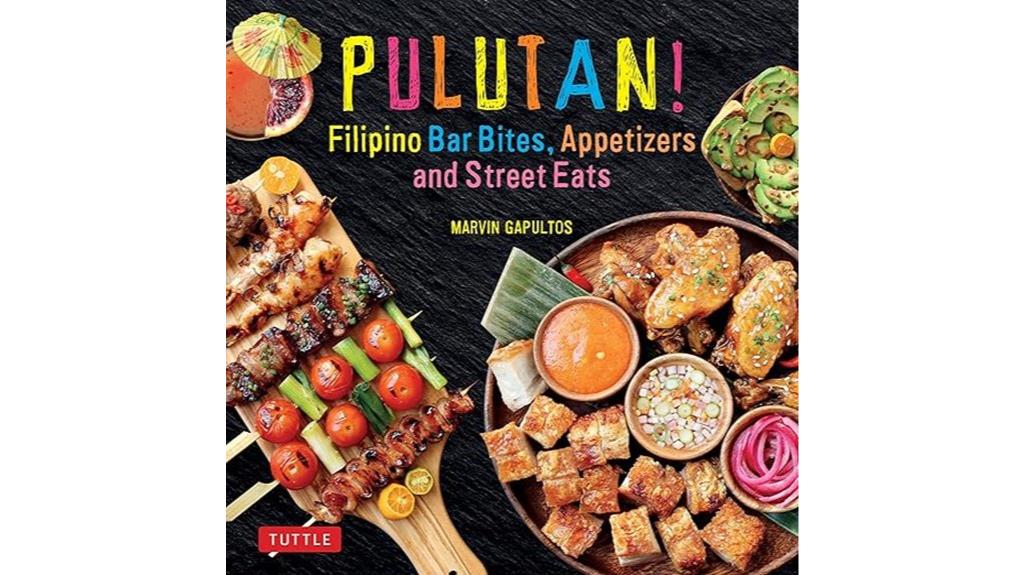
If you’re someone who loves entertaining friends or simply enjoys the vibrant flavors of Filipino cuisine, “Pulutan! Filipino Bar Bites, Appetizers and Street Eats” by Marvin Gapultos is a must-have. This cookbook features over 60 easy recipes perfect for pairing with drinks. I was particularly excited by the variety, from Grilled Coconut and Lemongrass Shrimp to Fried Calamari with Crispy Purple Yam Crust. Marvin’s engaging style made cooking feel personal, while the beautiful illustrations guided me through each dish. Plus, his beer pairing tips elevated my gatherings, celebrating the joy of sharing delicious meals with friends and family.
Best For: Those who love Filipino cuisine and enjoy entertaining with easy-to-make bar bites and appetizers.
Pros:
- Engaging narratives and approachable writing style make the recipes feel personal and relatable.
- Beautiful illustrations and easy-to-follow instructions enhance the cooking experience for home cooks.
- Includes beer pairing suggestions for each dish, perfect for elevating social gatherings.
Cons:
- May require access to a Filipino grocery or Asian supermarket for certain ingredients.
- Some recipes may be considered less familiar or challenging for those not accustomed to Filipino flavors.
- Limited to finger foods and appetizers, which may not cater to those seeking full meal recipes.
FILIPINO STREET FOOD: MANILA – CEBU – DAVAO TOP STREET FOOD RECIPES

For anyone keen to explore the bustling flavors of the Philippines, the “Filipino Street Food Cookbooks” is an invaluable resource. It takes you on a culinary journey through Manila, Cebu, and Davao, showcasing iconic street foods. In Luzon, I love indulging in isaw and kwek-kwek, which are perfect on-the-go snacks. Over in Visayas, batchoy warms my heart, while piaya satisfies my sweet tooth. Mindanao’s pastil and grilled delights offer a rich taste of the region’s diversity. This cookbook beautifully illustrates how every area contributes unique flavors, making it a must-have for anyone keen to recreate these vibrant dishes at home.
Best For: Food enthusiasts looking to explore and recreate authentic Filipino street food recipes from various regions of the Philippines.
Pros:
- Diverse Recipes: Offers a wide variety of street food recipes from Manila, Cebu, and Davao, showcasing regional flavors.
- Culinary Journey: Provides insights into the cultural significance and origins of each dish, enhancing the cooking experience.
- Easy to Follow: Recipes are designed to be accessible for home cooks of all skill levels, making it easy to replicate beloved street foods.
Cons:
- Limited Availability: Some ingredients may be hard to find outside the Philippines, potentially limiting recipe execution.
- Regional Focus: The focus on specific regions may not cover all popular street foods across the entire country.
- Preparation Time: Some recipes may require more time and effort than typical quick snacks, which could deter busy individuals.
I Am a Filipino: And This Is How We Cook
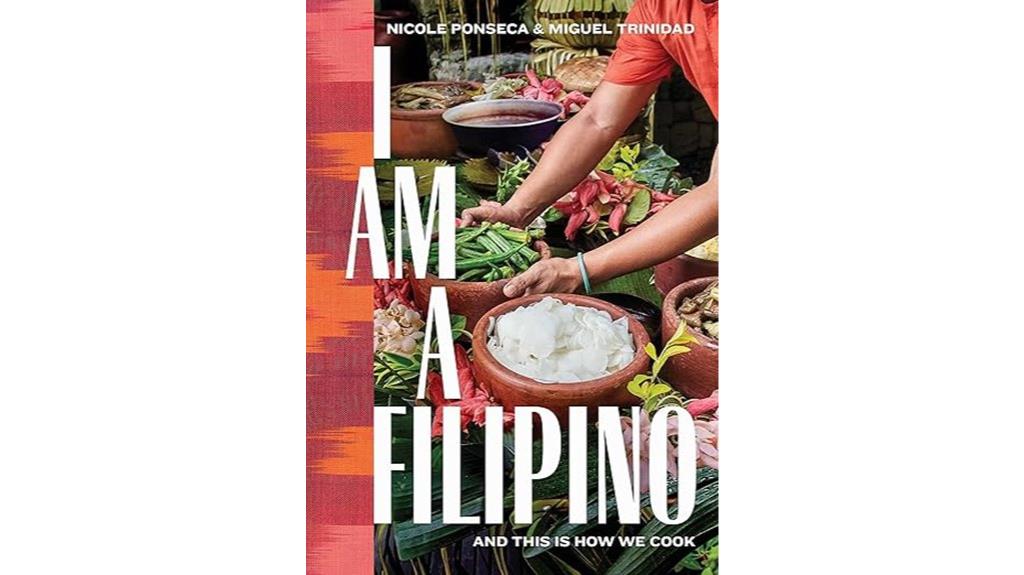
“I Am a Filipino: And This Is How We Cook” stands out as the perfect choice for anyone enthusiastic to dive deeper into Filipino culture through its vibrant cuisine. It’s more than just a cookbook; it’s a narrative that captures the essence of over 7,000 islands. I love how it presents everyday recipes like adobo and kare kare, making them accessible for all cooks. The bold photographs beautifully showcase our culinary traditions, though I wish they had more context for non-Filipinos. This book has helped me reconnect with my heritage, making it a wonderful gift for anyone wanting to understand Filipino food.
Best For: Anyone looking to explore and understand Filipino culture through authentic and accessible culinary experiences.
Pros:
- Features a variety of everyday Filipino recipes that are easy to follow.
- Includes bold and vibrant photographs that enhance the cooking experience.
- Serves as a cultural narrative, helping readers reconnect with Filipino heritage.
Cons:
- Some ingredients may only be available at specialty stores.
- Lack of context in photographs might confuse non-Filipino readers.
- Inconsistent use of non-English terms could lead to confusion for some readers.
The Easy Filipino Cookbook: 100 Classics Made Simple
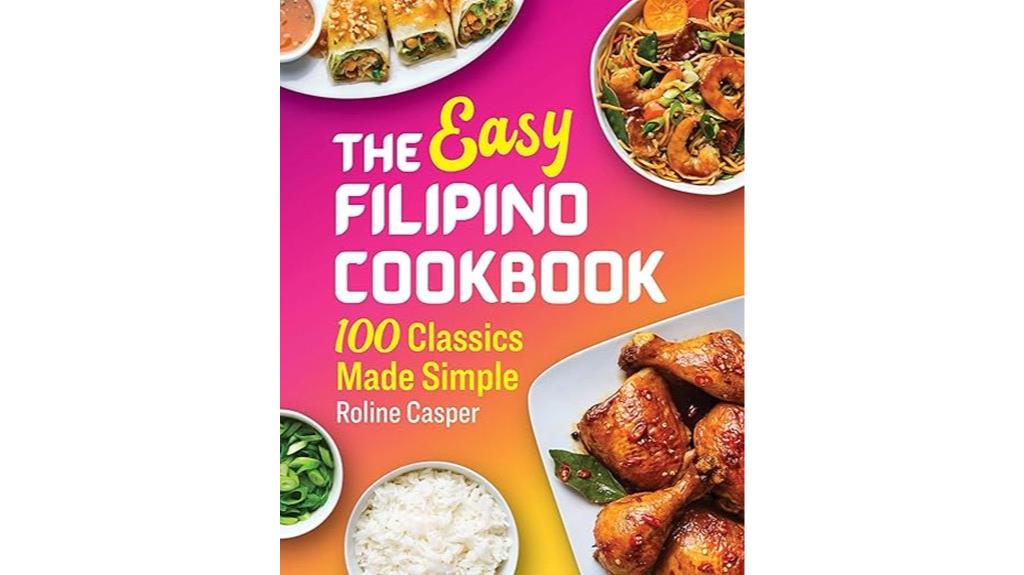
The Easy Filipino Cookbook: 100 Classics Made Simple is perfect for anyone enthusiastic to plunge into the vibrant world of Filipino cuisine without feeling overwhelmed. With 100 classic recipes, this book makes it easy to explore and share authentic flavors. I love how it offers substitutes for ingredients, catering to various tastes. The well-formatted instructions are a lifesaver, ensuring that even beginners can succeed—5 out of 6 recipes reportedly hit the mark! While I wish there were more pictures to inspire me, the cultural insight and regional diversity make this cookbook a delightful addition to any kitchen.
Best For: Home cooks looking to explore and share authentic Filipino cuisine with ease.
Pros:
- Delicious and easy-to-follow recipes: 5 out of 6 recipes reportedly successful, making it beginner-friendly.
- Ingredient substitutes provided: Accommodates various tastes and dietary preferences.
- Cultural insights included: Showcases the regional diversity of Filipino cuisine, enhancing the cooking experience.
Cons:
- Lack of visual references: Limited pictures for individual dishes may hinder the cooking experience.
- Potential for ingredient availability issues: Some traditional ingredients may not be easily accessible to all readers.
- More photos suggested for improvement: Readers expressed a desire for additional images to inspire and guide them.
Quintessential Filipino Cooking: 75 Authentic Recipes
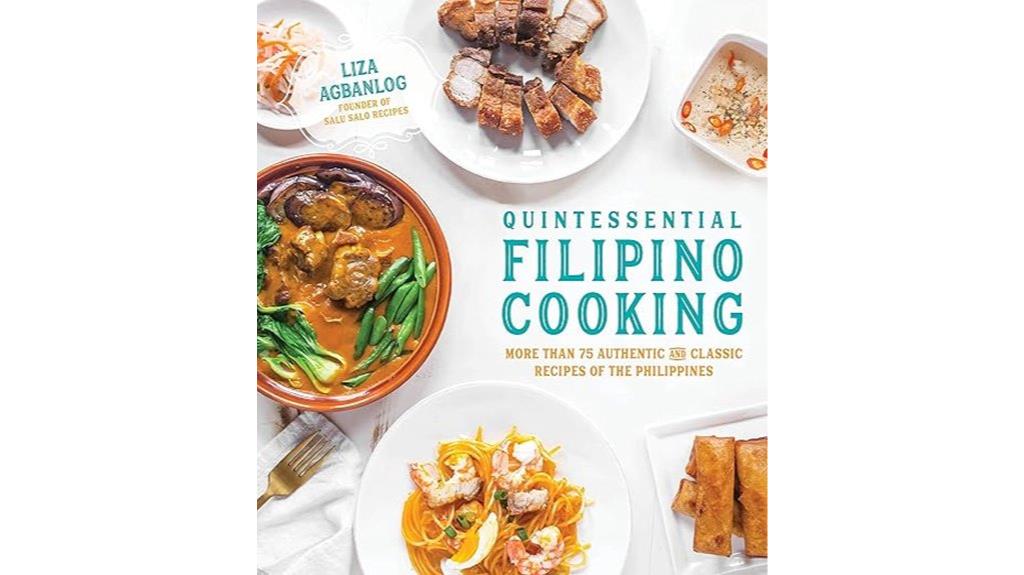
Quintessential Filipino Cooking: 75 Authentic Recipes stands out as a must-have for anyone keen to explore the rich flavors of Filipino cuisine. Liza’s cookbook beautifully marries tradition with accessibility, offering clear instructions and short ingredient lists that even beginners can follow. Each recipe is accompanied by vibrant photos that not only guide you but also inspire your kitchen decor. As I flipped through the pages, I felt a wave of nostalgia, reconnecting with my roots. It’s a fantastic resource for both novice and experienced cooks, making it easy to share these cherished culinary traditions with loved ones.
Best For: Anyone looking to explore and learn authentic Filipino cuisine, from beginners to experienced cooks.
Pros:
- Clear and concise instructions make it easy for novice cooks to follow.
- Vibrant full-color photos enhance the cooking experience and serve as kitchen decor.
- Cultural connection helps readers reconnect with their heritage through traditional recipes.
Cons:
- Some recipes may include exotic ingredients that could be hard to find in certain areas.
- Limited variability in recipes for those seeking more complex culinary challenges.
- Nostalgia factor may not resonate with readers unfamiliar with Filipino culture.
The World of Filipino Cooking by Chris Urbano

For anyone enthusiastic to plunge into the vibrant world of Filipino cuisine, “The World of Filipino Cooking” by Chris Urbano serves as an essential guide. Urbano’s journey through Filipino culture and language enriches every page, showcasing over 90 easy-to-follow recipes. I appreciate how he highlights the eclectic flavors shaped by the Philippines’ unique history. Each recipe, from Chicken Adobo to Lumpiang Shanghai, uses common ingredients and straightforward directions, making it accessible for all home cooks. Despite missing a few popular dishes, this beautifully illustrated book offers a delightful introduction to the rich culinary landscape of the Philippines, perfect for any food lover.
Best For: Anyone interested in exploring Filipino cuisine, from novice home cooks to seasoned food enthusiasts.
Pros:
- Richly illustrated with appetizing photographs that enhance the cooking experience.
- Easy-to-follow recipes using common ingredients, making it accessible for all cooking levels.
- Personal anecdotes add a unique touch, enriching the cultural context of each dish.
Cons:
- Missing some popular dishes like Sisig and Crispy Pata, which may disappoint some readers.
- Minor typographical errors present in the text, which could distract some users.
- Limited focus on more experimental or modern interpretations of Filipino cuisine.
Filipino Recipes Cookbook

If you’re someone who craves the vibrant flavors of Filipino cuisine, the “Filipino Recipes Cookbook” is perfect for you. It showcases a delightful mix of authentic dishes influenced by various cultures, making each meal an adventure. I love how the recipes evoke nostalgia, reminding me of childhood meals. The format is straightforward, making cooking enjoyable. While some ingredients are easy to find, a few can be a challenge, and seafood options are limited. Still, this cookbook beautifully highlights the Philippines’ culinary heritage, inviting you to explore and embrace new flavors that tell a story. Immerse yourself and savor the experience!
Best For: Those who appreciate authentic Filipino cuisine and want to explore diverse flavors while reminiscing about childhood meals.
Pros:
- Authentic Recipes: Offers a collection of traditional Filipino dishes influenced by various cultures.
- Nostalgic Experience: Many recipes evoke fond childhood memories, enhancing the cooking experience.
- Easy-to-Follow Format: The straightforward instructions make it accessible for cooks of all skill levels.
Cons:
- Limited Seafood Options: The cookbook features a restricted selection of seafood recipes, which might disappoint some readers.
- Hard-to-Find Ingredients: Some recipes may require ingredients that are difficult to source.
- Lack of Variety: A few readers have noted that the selection of recipes could be more diverse and inspiring.
Thai Street Food: Authentic Recipes, Vibrant Traditions [A Cookbook]
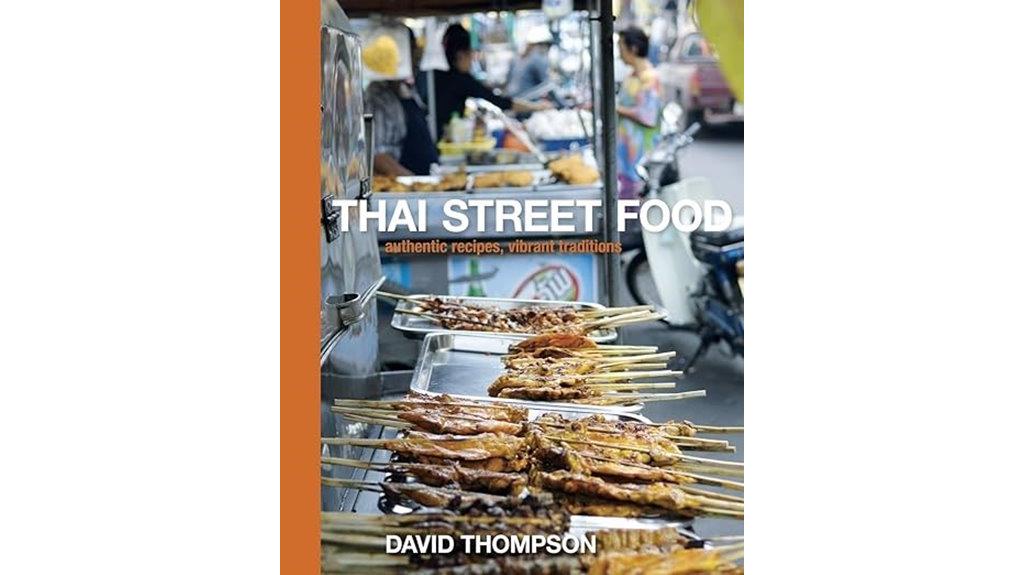
Those passionate about exploring the vibrant world of Thai street food will find “Thai Street Food: Authentic Recipes, Vibrant Traditions” by David Thompson to be an invaluable resource. This cookbook showcases nearly 100 authentic dishes, making the essence of Thai street food accessible for home cooks. The high-quality photographs not only entice but also immerse you in the culture, depicting bustling markets and rich traditions. While the book’s size can be cumbersome, the detailed recipes and helpful Thai transliterations guarantee your dishes taste just like those from Thailand. If you’re interested in Thai cuisine, this book is a must-have!
Best For: Those interested in authentic Thai cuisine and culture who want to recreate street food dishes at home.
Pros:
- Authentic recipes that closely replicate the flavors of Thai street food.
- High-quality photographs that enhance the visual appeal and cultural understanding of Thai food.
- Helpful Thai transliterations of ingredients, making it easier for home cooks to source authentic components.
Cons:
- The size and weight of the book can make it impractical for kitchen use.
- The Kindle version contains only a fraction of the recipes, leading to disappointment for some readers.
- A companion text focusing solely on recipes would improve usability and accessibility.
Filipino Cookbook 175: Tasting Filipino Cuisine
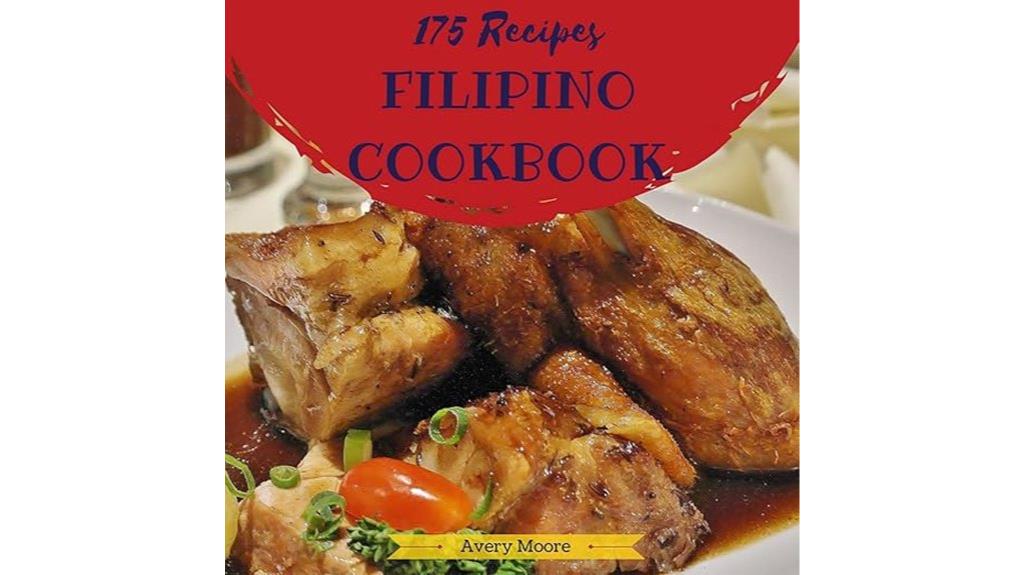
“Filipino Cookbook 175: Tasting Filipino Cuisine” is perfect for anyone enthusiastic to explore the vibrant flavors of Filipino food without spending hours in the kitchen. With 175 easy-to-follow recipes, this cookbook helps me whip up healthy and quick meals that are both delicious and accessible. The organized chapters, covering main dishes, soups and stews, desserts, and unique recipes, make it a breeze to navigate. Each recipe is tested for quality, ensuring I’ve got balanced meals every time. Plus, the illustrations really help me understand the cooking process. It’s a delightful gateway to sharing Filipino culinary traditions!
Best For: Anyone looking to easily explore and prepare healthy Filipino cuisine at home without spending too much time in the kitchen.
Pros:
- Easy-to-follow recipes that cater to both beginners and experienced cooks.
- Organized chapters for quick navigation through various Filipino dishes and desserts.
- Illustrations included to enhance understanding of the cooking process.
Cons:
- Limited to only Filipino recipes, which may not appeal to those looking for a wider variety of international cuisines.
- Some recipes may require specific ingredients that could be hard to find in certain areas.
- The focus on quick meals might overlook traditional, more time-intensive Filipino cooking methods that some purists may prefer.
Filipino Foods Alphabet: Philippine Cuisines from A to Z
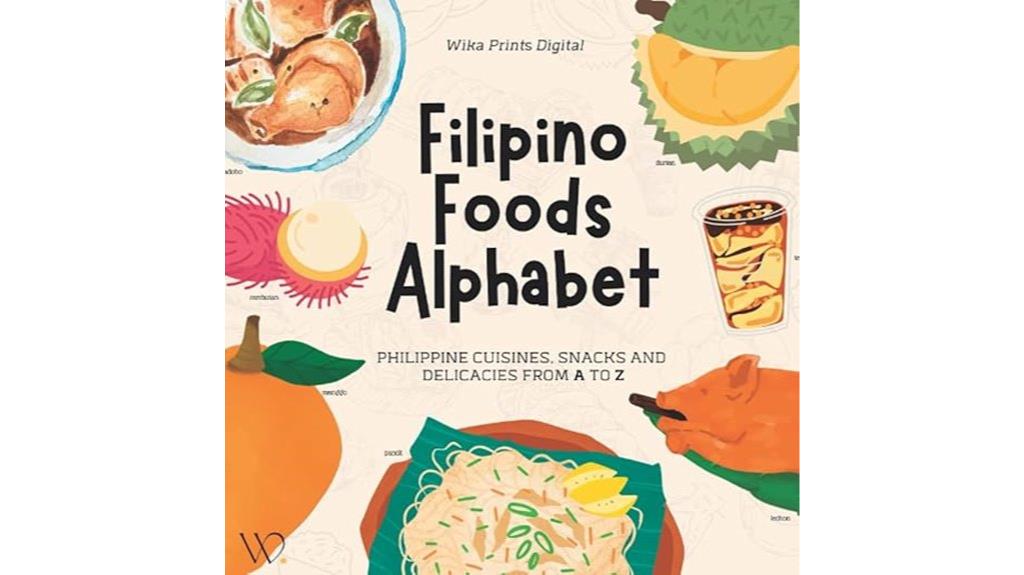
For anyone looking to explore the vibrant world of Philippine cuisine, “Filipino Foods Alphabet” is an excellent choice. This engaging book introduces 46 delicious Filipino foods, street snacks, and fruits from A to Z, making it a fun learning experience for both kids and adults. With 50 colorful pages filled with bright illustrations, it captures young readers’ interest while teaching them about our rich culinary heritage. I love how it emphasizes reconnecting with our identity through food, fostering cultural appreciation. Whether you’re a beginner or a seasoned foodie, this book makes discovering Filipino flavors enjoyable and interactive!
Best For: Families and educators looking to teach children and adults about Filipino cuisine and culture in an engaging way.
Pros:
- Engaging Content: The book features vibrant illustrations and descriptions that capture the interest of young readers.
- Cultural Education: It serves as a valuable resource for understanding and appreciating Filipino heritage through food.
- Wide Appeal: Suitable for both children and adults, making it a versatile tool for learning.
Cons:
- Limited Scope: The book only covers 46 foods, which may not represent the full diversity of Filipino cuisine.
- Age Range: While designed for all ages, younger children may require assistance from adults to fully grasp the content.
- Physical Format: As a printed book, it may not be as accessible as digital resources for some readers.
Filipino Cookbook: 105 Mouthwatering Recipes
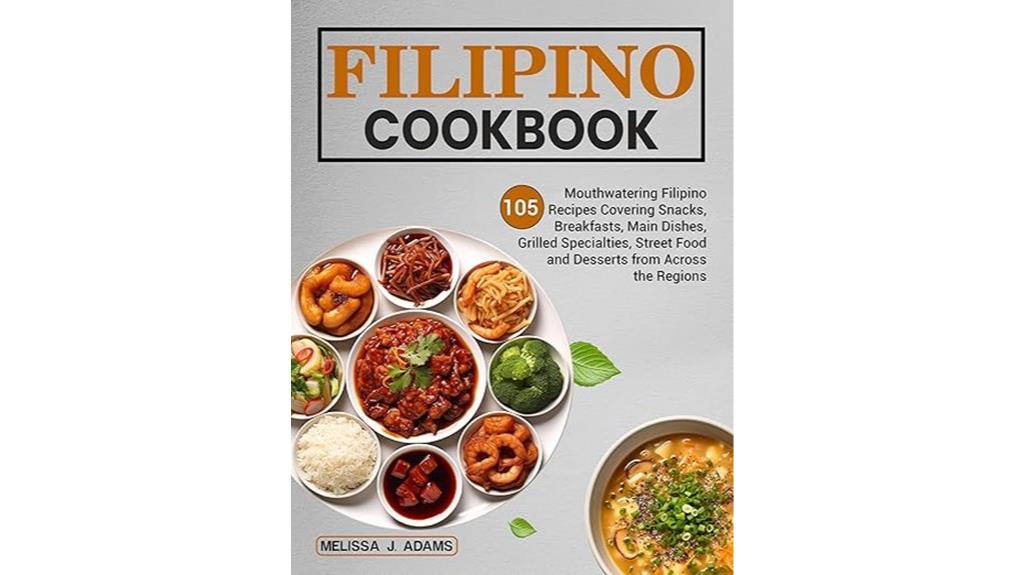
If you’re looking to explore the vibrant world of Filipino cuisine, “Filipino Cookbook: 105 Mouthwatering Recipes” is a fantastic choice. This cookbook beautifully showcases a blend of savory, sweet, and tangy dishes that reflect the Philippines’ rich cultural heritage. With 105 authentic recipes ranging from snacks like lumpia to hearty main dishes like adobo and sinigang, there’s something for everyone. The clear instructions and organized layout make it easy for both beginners and seasoned cooks to immerse themselves. Cooking these dishes isn’t just about satisfying hunger; it’s a delightful journey through Filipino traditions and flavors.
Best For: Anyone looking to explore and enjoy authentic Filipino cuisine, whether they are beginners or experienced cooks.
Pros:
- Clear step-by-step instructions make cooking accessible for all skill levels.
- A wide variety of recipes, covering everything from snacks to desserts, ensures there’s something for every palate.
- The organized layout allows for easy navigation, making it simple to find favorite recipes.
Cons:
- Some recipes may require hard-to-find ingredients outside of the Philippines.
- Certain traditional dishes might be time-consuming to prepare for novice cooks.
- Limited information on dietary substitutions for specific recipes.
The Quick and Easy Filipino Cookbook
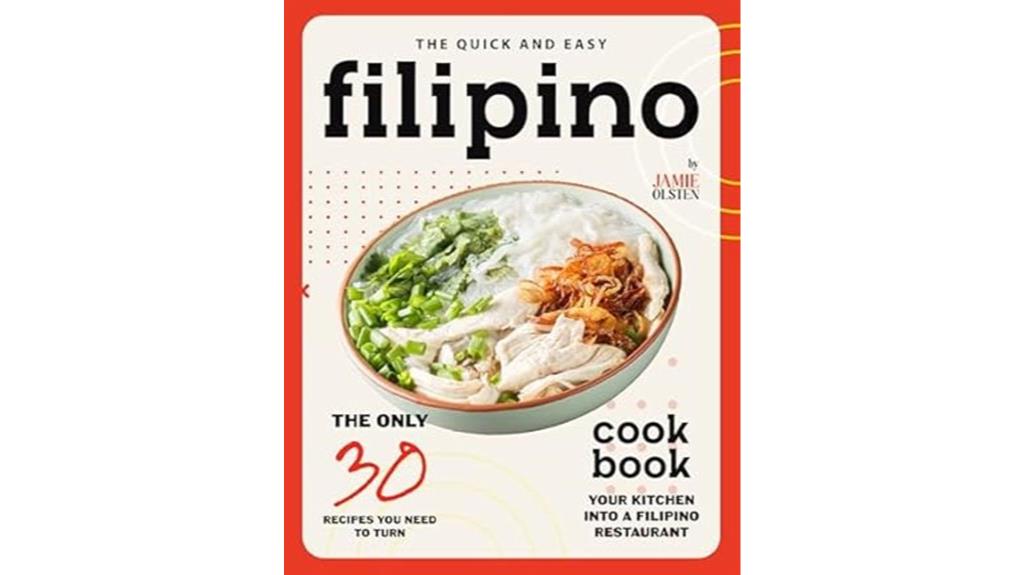
Looking to bring the vibrant flavors of the Philippines into your kitchen? The Quick and Easy Filipino Cookbook is your perfect companion! With 30 essential recipes, it helps you recreate beloved dishes reminiscent of family meals, especially those from our grandmothers. You’ll find crowd-pleasers like soy-vinegar chicken adobo, crispy pork belly, and the delightful halo-halo dessert. Each recipe is straightforward, using everyday ingredients you can find at local stores. I love how the friendly tone guides me through every step, making Filipino cooking accessible and enjoyable. Immerse yourself, and let’s savor these rich flavors together!
Best For: Anyone looking to explore Filipino cuisine with easy-to-follow recipes and accessible ingredients.
Pros:
- Clear instructions make it suitable for cooks of all skill levels, including beginners.
- Features a variety of beloved Filipino dishes that appeal to many tastes.
- Friendly, conversational tone enhances the cooking experience and encourages family involvement.
Cons:
- Limited to 30 recipes, which may not cover all popular Filipino dishes.
- Some readers may find the recipes too simplified if they seek more advanced techniques.
- Availability of specific Filipino ingredients may vary based on location.
85 Quintessential Filipino Flavors: Recipes Celebrating the Culinary Heritage
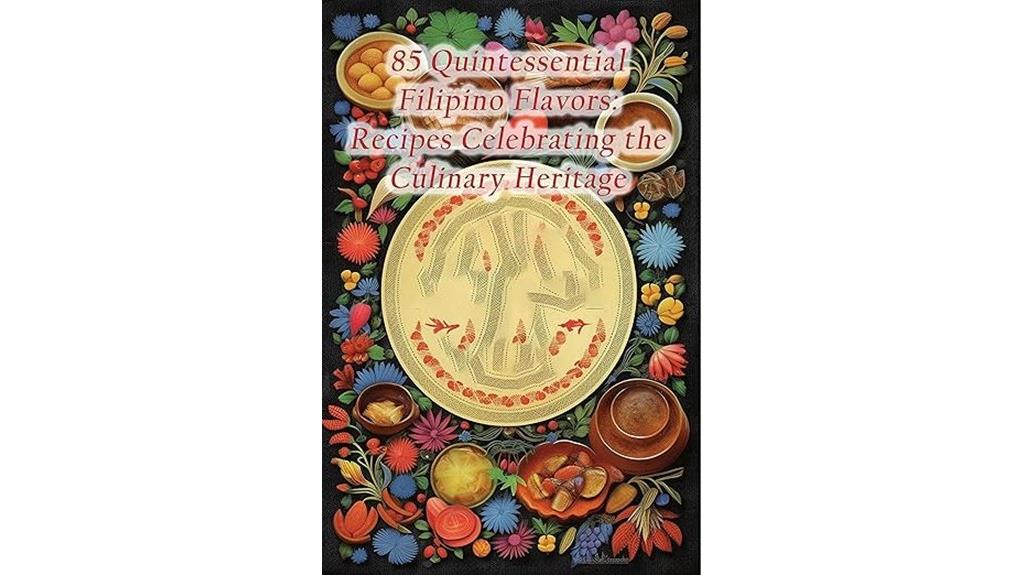
The “85 Quintessential Filipino Flavors: Recipes Celebrating the Culinary Heritage” cookbook stands out as the ideal choice for anyone enthusiastic to immerse themselves in the vibrant world of Filipino cuisine. This collection showcases 85 authentic recipes that blend influences from Spanish, Malaysian, and Chinese cultures. I love that it features classic dishes like Kare-Kare and Adobo, along with innovative options like Bacon Lumpia. Each recipe includes stunning photographs and easy-to-follow instructions, making it accessible for both novice cooks and seasoned chefs. It’s a perfect way to explore the rich culinary heritage of the Philippines right in your kitchen!
Best For: Anyone looking to explore and enjoy authentic Filipino cuisine, from novice cooks to seasoned chefs.
Pros:
- Diverse Recipes: Offers a wide range of both classic and innovative Filipino dishes, catering to various tastes.
- User-Friendly: Includes step-by-step instructions and helpful cooking tips, making it accessible for cooks of all skill levels.
- Visual Appeal: Each recipe is accompanied by stunning photographs, enhancing the cooking experience and presentation.
Cons:
- Limited Scope: Focuses exclusively on Filipino cuisine, which may not appeal to those seeking a broader range of international recipes.
- Ingredient Availability: Some traditional Filipino ingredients might be hard to find in certain regions, potentially complicating recipe preparation.
- Cultural Context: Lacks detailed background information on the cultural significance of each dish, which some readers may find valuable.
Amboy: Recipes from the Filipino-American Dream
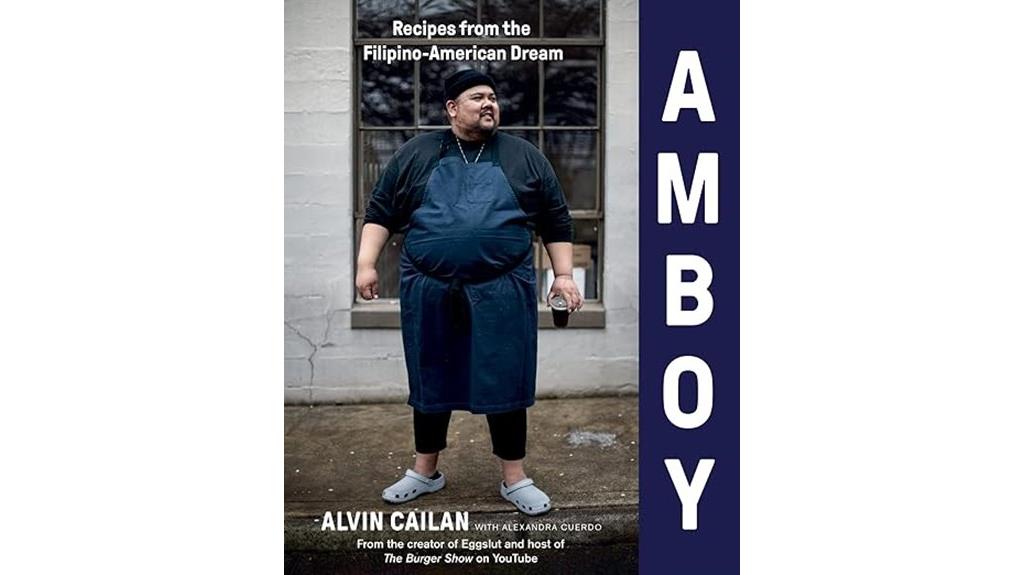
“Amboy: Recipes from the Filipino-American Dream” stands out as the perfect choice for anyone keen to explore authentic Filipino cuisine through the eyes of a passionate chef. Chef Alvin Cailan shares his culinary journey, emphasizing foundational techniques and cultural significance. I love how he offers practical tips, like cooking Jasmine rice without a rice cooker. The recipes, such as Pan de Sal and Patis fried chicken, resonate deeply with readers, evoking nostalgia. While some reports mention binding issues, the book’s engaging layout and heartfelt storytelling truly shine. This cookbook is a treasure for anyone wanting to connect with Filipino flavors at home.
Best For: Anyone looking to delve into authentic Filipino cuisine and connect with their cultural roots through a passionate chef’s insights.
Pros:
- Engaging storytelling that highlights Chef Alvin Cailan’s personal journey and the significance of Filipino cuisine.
- Practical cooking tips provided throughout the recipes, making traditional dishes accessible for home cooks.
- High-quality photography and a well-organized layout that enhances the cooking experience.
Cons:
- Some customers reported binding issues with the physical copies of the book.
- A few users experienced damaged copies upon delivery, leading to the need for replacements.
- Navigation warnings in the Kindle version, though most found it easy to use despite the issues.
Filipino Cookbook: A Journey of Aromas and Tastes from the Philippines
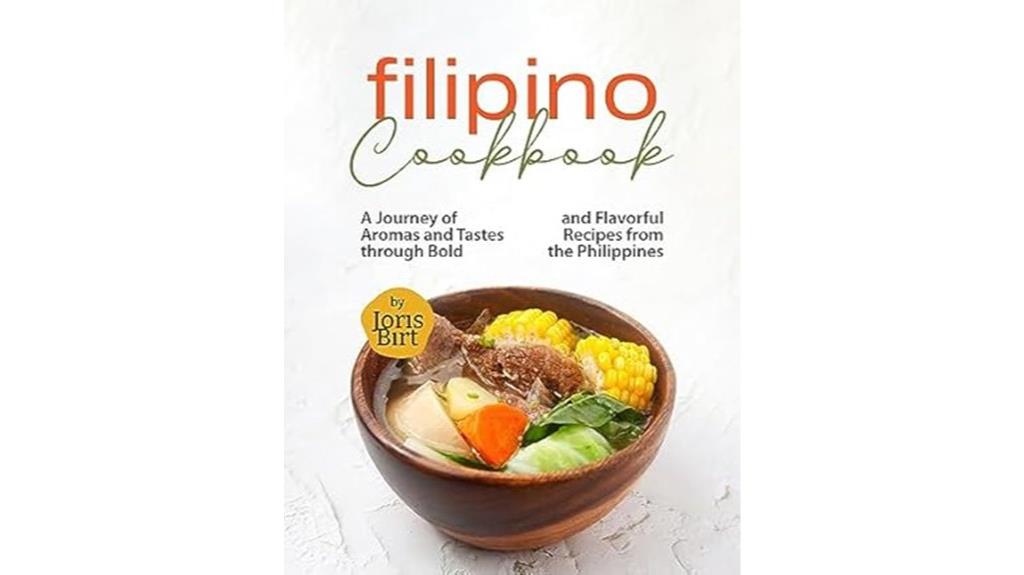
If you’re enthusiastic to explore the rich tapestry of Filipino flavors from the comfort of your kitchen, “Filipino Cookbook: A Journey of Aromas and Tastes from the Philippines” is your perfect companion. This cookbook beautifully captures our cultural heritage with time-honored family recipes that resonate with tradition. I love how it showcases bold spices and irresistible aromas, inviting me to recreate the warmth of home-cooked meals. Each recipe encourages me to engage fully with the cooking process, diving into the diverse regions of the Philippines. It’s a delightful journey that leaves me craving more of our unique culinary wonders!
Best For: Anyone looking to explore and recreate the vibrant and diverse flavors of Filipino cuisine from their own kitchen.
Pros:
- Cultural Connection: Offers authentic family recipes that celebrate Filipino heritage and traditions.
- Flavorful Experience: Features bold spices and aromatic dishes that create a delightful cooking experience.
- Engaging Cooking: Encourages hands-on involvement, allowing readers to immerse themselves in the culinary journey of the Philippines.
Cons:
- Availability of Ingredients: Some recipes may require hard-to-find ingredients that are not readily available outside of the Philippines.
- Skill Level Required: Certain dishes may be complex and require advanced cooking skills, which could be challenging for beginners.
- Limited Dietary Options: May not cater to specific dietary restrictions or preferences, as traditional Filipino cuisine often includes meat and seafood.
Factors to Consider When Choosing Filipino Street Food Cookbooks
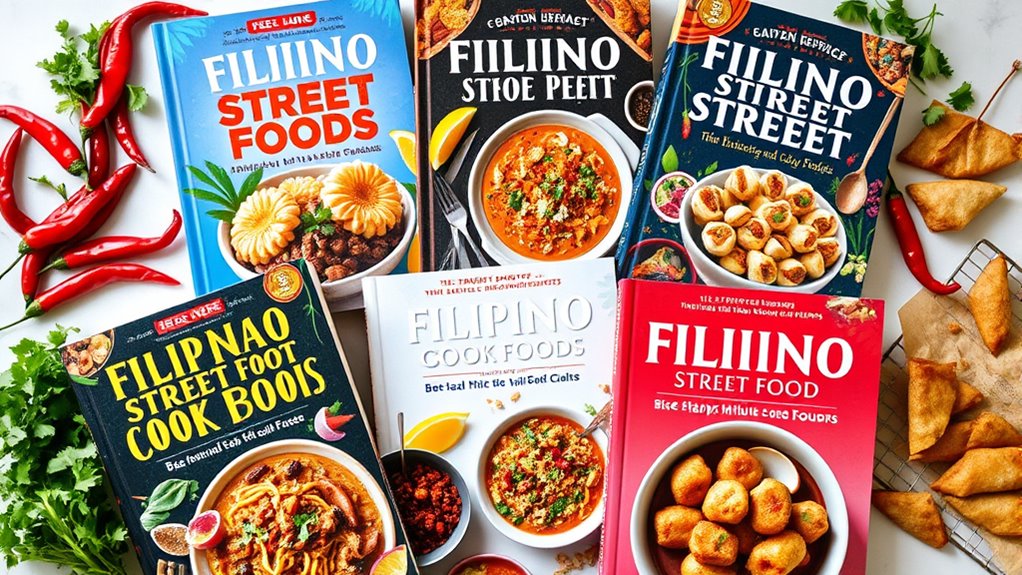
When I pick a Filipino street food cookbook, I always consider a few key factors. I want to make sure the recipes are authentic and varied, but I also think about how accessible the ingredients are. Plus, a bit of cultural context and appealing visuals can really enhance my cooking experience.
Recipe Authenticity and Variety
Choosing a Filipino street food cookbook can feel overwhelming, but focusing on recipe authenticity and variety will make your selection easier. I recommend looking for cookbooks that showcase a diverse range of recipes from Luzon, Visayas, and Mindanao. This approach guarantees you experience the full spectrum of iconic street snacks. Authenticity is key, so opt for cookbooks that emphasize traditional preparation methods and common ingredients found in Filipino street food culture. It’s also crucial to include both classic and innovative dishes, allowing for creative adaptations in your cooking. Finally, consider cookbooks that provide cultural context, helping you appreciate each dish’s significance in the vibrant landscape of Filipino street food. Enjoy your culinary journey!
Ingredient Accessibility and Substitutes
Exploring the rich tapestry of Filipino street food wouldn’t be complete without considering ingredient accessibility and substitutes. When I choose a cookbook, I always look for recipes that use ingredients I can easily find at my local grocery store. Some recipes may require hard-to-find components, so it’s a relief when cookbooks offer substitutions. This adaptability allows me to recreate authentic flavors without the stress of sourcing rare items. I also appreciate cookbooks that suggest where to find specific ingredients, like Filipino grocery stores or Asian markets. Knowing which items are readily available and which might need special sourcing is essential for my cooking success. This approach not only enhances my experience but also keeps the spirit of Filipino cuisine alive in my kitchen.
Cultural Context and Background
Understanding the cultural context and background of Filipino street food enriches my experience as I immerse myself in various cookbooks. Each dish tells a story, reflecting the Philippines’ diverse culinary heritage shaped by regional flavors and traditions. I’ve noticed that street food often brings people together, with bustling markets serving as lively hubs for social interaction. Ingredients like rice, soy sauce, and vinegar highlight the unique and bold flavors of the archipelago. Plus, street food offers an accessible way to explore Filipino cuisine, providing affordable and quick meal options deeply rooted in local culture. I appreciate how specific street foods vary by region, showcasing the rich culinary diversity throughout the country, making every cookbook a treasure trove of flavors.
Cooking Skill Level Required
When diving into Filipino street food cookbooks, it’s important to take into account the cooking skill level required for each one. If you’re a beginner, look for cookbooks with clear, step-by-step instructions and simple ingredient lists. These make it easier to grasp the basics of Filipino cuisine. For those with some experience, intermediate-level cookbooks offer more complex techniques and a broader variety of ingredients, perfect for expanding your skills. However, if you’re a seasoned chef, advanced cookbooks feature intricate recipes that can challenge your expertise, often requiring specialized equipment. Additionally, always check for recipe testing and user feedback, as these can indicate how accessible the dishes are across various skill levels, ensuring a successful cooking experience.
Visual Presentation and Photography
Visual presentation and photography are essential components that can elevate your experience with Filipino street food cookbooks. High-quality photographs not only enhance your cooking journey but also provide vital visual cues for both preparation and presentation. I love how colorful and vivid illustrations capture the essence of Filipino cuisine, evoking nostalgia and drawing me deeper into its rich culture. Effective visuals can clarify complex techniques and ingredient combinations, making it easier for you to replicate these traditional dishes. I find that cookbooks featuring images of finished dishes and key ingredients help me recognize unfamiliar items. Without photographs, a cookbook can lose its appeal, as those visuals often motivate me to try new recipes.
Organization and Layout Clarity
Choosing the right Filipino street food cookbook means paying close attention to organization and layout clarity. A well-organized cookbook categorizes recipes by type—snacks, main dishes, desserts—making it easy to find exactly what you’re craving. Look for clear headings, subheadings, and a table of contents that enhance navigation, allowing you to quickly locate your desired recipes. I appreciate when recipes feature concise, step-by-step instructions; this guarantees even novice cooks can follow along without confusion. Visual aids, like photographs, help me understand the finished dish and spark my creativity for presentation. Finally, consistent formatting throughout—font styles, ingredient listings, and measurement units—creates a user-friendly experience and minimizes cooking mishaps.
Personal Stories and Anecdotes
How do personal stories and anecdotes enhance the experience of exploring Filipino street food cookbooks? They breathe life into recipes, sharing the cultural significance behind each dish. When authors recount their culinary journeys or cherished memories, I feel a deeper connection to the flavors and traditions. These anecdotes often highlight how street food brings people together during celebrations, making me nostalgic for communal meals. I’m inspired to recreate those moments in my kitchen, fostering a greater appreciation for the cuisine. Additionally, stories about family recipes passed down through generations remind me of the importance of preserving culinary heritage. It encourages me to explore my own family’s connections to food, enriching my cooking experience.
Frequently Asked Questions
What Kitchen Tools Are Essential for Making Filipino Street Food?
When making Filipino street food, I find a few kitchen tools essential. First, a heavy-duty frying pan or wok is vital for crispy dishes like lumpia. A sharp knife and cutting board help me prep ingredients quickly. I also rely on a sturdy spatula for flipping and stirring. Finally, a food thermometer guarantees my meats cook perfectly. With these tools, I can create delicious street food right in my own kitchen!
How Can I Substitute Hard-To-Find Ingredients in Filipino Recipes?
I’d love to say you can just wave a magic wand to find every ingredient, but alas, that’s not how cooking works! When a hard-to-find ingredient pops up, I often substitute with what’s available. For instance, if I can’t find shrimp paste, I use a mix of soy sauce and a dash of fish sauce. It’s not exact, but it keeps the dish flavorful. Experimenting is half the fun, right?
Are There Vegetarian Options in Filipino Street Food Cookbooks?
I’ve found that many Filipino street food cookbooks offer delicious vegetarian options. For example, you can enjoy dishes like vegetable lumpia or tofu silog, which are both flavorful and satisfying. I love experimenting with plant-based ingredients, and these recipes often highlight the rich flavors of traditional Filipino cuisine without meat. If you’re looking to explore, I definitely recommend checking out those vegetarian sections in the cookbooks for tasty ideas!
Can I Freeze Filipino Street Food for Later Consumption?
Freezing Filipino street food is like capturing a moment in time; it lets you savor those vibrant flavors later. I’ve found that many dishes, especially those like lumpia or adobo, freeze well. Just make sure to cool them completely before sealing them tightly in freezer bags. When you’re ready to enjoy them, thaw and reheat, and they’ll taste almost as fresh as the day you made them! Give it a try; you won’t regret it!
How Long Do Filipino Street Food Dishes Typically Last in the Fridge?
When it comes to Filipino street food, I’ve found that most dishes last about 3 to 5 days in the fridge if stored properly. It’s essential to keep them in airtight containers to maintain their flavor and texture. However, I always recommend checking for any off smells or changes in appearance before digging in. If you’re unsure, it’s better to err on the side of caution and toss it out. Enjoy your leftovers!
Conclusion
To sum up, diving into these Filipino street food cookbooks is like starting a culinary adventure that’ll transport you straight to the bustling streets of Manila. Each recipe bursts with authentic flavors that’ll make your taste buds dance with joy. Whether you’re a seasoned cook or just starting out, these books will guide you to create mouthwatering dishes that’ll impress your family and friends. So grab one, and let the delicious journey begin!









